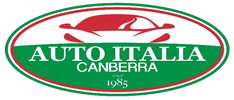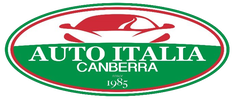AUTO ITALIA – JUDGING GUIDELINES
Introduction:
The Auto Italia prizes have developed from being a simple show and shine competition for individual marques, to having several categories and then an overall Best of Show award that is supervised by internationally regarded car judges.
Judging:
The judging follows a five-stage process:
The first stage involves the person displaying the car indicating that he or she wants their car judged, and then parking the car in the correct area for the car’s category. Cars to be judged will have a circular sticker placed on the windscreen. This sticker will be ticked once the car has been judged.
The second stage involves the judging of cars within their categories, performed by the car clubs for the marques. These will be judged on an external inspection of the car. More information is provided in the Basis of Scoring section. The winners of this judging stage will receive Auto Italia trophies for their cars.
The third stage is a down-selection process for the Best of Show trophy. This is performed by the Auto Italia judges. These cars will be brought to the centre of the oval, having done some parade laps of the velodrome.
The final two stages involve the Auto Italia judges choosing the finalist for the Best of Show. The Best of Show is then judged on a more subjective level by the honorary judges.
Basis of Scoring:
The scoring in the first three stages is determined strictly from an external visual inspection of the vehicle.
Bonnets, boots or doors are not required to be opened during the inspection.
The intent of the scoring is to place a competitor’s car on a scale that accommodates appearance, condition and preparation, with a view to rewarding the best example in the class. The presence of defects, poor preparation, or modifications unsympathetic to the vehicle, will be taken into account.
Scored Items (second stage):
All items are to be scored numerically with values between zero and ten, 0 being absent and 10 being best/faultless:
Bodywork – form and condition with absence of dents, defects and degradation;
Paint – gloss, absence of water marks, polish residue, swirls or scratches;
Glass (windows, lights and mirrors) – cleanliness, absence of scratching;
Wheels & Tyres - clean & undamaged;
Brightwork (chrome and contrasting trim, e.g. window surrounds, mirror casing etc.) cleanliness, absence of scratching, defects, polish residue;
Cabin interior (Steering wheel, dash, seats) - viewed through the windows! – condition, clean and tidy – dash mats and seat covers are acceptable but their condition will be taken into account.
Badges – as for brightwork;
Items excluded from the marque judging (second stage):
underneath of the vehicle
inside of the engine bay or boot
areas not visible when the doors are closed.
Auto Italia is not a concorso event and therefore originality of an exhibit is not a requirement
Best of Show Judging criteria
From the winners of second stage, eight cars, a bike and a scooter will be selected for the Best of Show judging.
The Best of Show Judging adds scoring of the interior, engine bay and boot of the car. The underside of the car is not checked. Greater attention is paid to paint quality, such as the absence of ‘orange peel’ and the consistency of panel gaps, and the overall appearance of the interior. The cleanliness of the engine bay and boot is also considered. Applicable adjustments will be made to judging bikes and scooters given they lack an interior and probably do not have storage such as paniers.
After this objective scoring the three or four finalists are selected.
The final Best of Show judging is performed by the honorary judges and is more subjective in nature, with the overall condition mixed with the subjective ‘wow factor’ felt by the honorary judges on the day. This process will favour restored cars over well preserved, original cars.
All decisions of the Judging Panel will be final.
In the event of a tied decision between judges, the Chief Judge will cast, or delegate another panel member to cast, a deciding vote.
Any issue relating to judging, by exhibitors or judges, must be referred to the Chief Judge for resolution.
For Best of Marque Judging
Judges will not be judges of classes in which they are also an exhibitor.
Judges are not required to be familiar (or expert) with the class that they are judging.
Judges are not required to touch a vehicle to assess it, and this should be avoided for the sake of consistency.
Judges should assess each car carefully and consistently with respect to all others in the class.
Judging of each class should be done by at least two persons, where possible.
Judges should be prepared to explain their scoring to the Chief Judge.
The Auto Italia standard score sheets should be used to record judges’ results.
Judges should provide a single consolidated score sheet for each class.,
All requests for feedback on the judging will be referred to the Chief Judge.
Introduction:
The Auto Italia prizes have developed from being a simple show and shine competition for individual marques, to having several categories and then an overall Best of Show award that is supervised by internationally regarded car judges.
Judging:
The judging follows a five-stage process:
The first stage involves the person displaying the car indicating that he or she wants their car judged, and then parking the car in the correct area for the car’s category. Cars to be judged will have a circular sticker placed on the windscreen. This sticker will be ticked once the car has been judged.
The second stage involves the judging of cars within their categories, performed by the car clubs for the marques. These will be judged on an external inspection of the car. More information is provided in the Basis of Scoring section. The winners of this judging stage will receive Auto Italia trophies for their cars.
The third stage is a down-selection process for the Best of Show trophy. This is performed by the Auto Italia judges. These cars will be brought to the centre of the oval, having done some parade laps of the velodrome.
The final two stages involve the Auto Italia judges choosing the finalist for the Best of Show. The Best of Show is then judged on a more subjective level by the honorary judges.
Basis of Scoring:
The scoring in the first three stages is determined strictly from an external visual inspection of the vehicle.
Bonnets, boots or doors are not required to be opened during the inspection.
The intent of the scoring is to place a competitor’s car on a scale that accommodates appearance, condition and preparation, with a view to rewarding the best example in the class. The presence of defects, poor preparation, or modifications unsympathetic to the vehicle, will be taken into account.
Scored Items (second stage):
All items are to be scored numerically with values between zero and ten, 0 being absent and 10 being best/faultless:
Bodywork – form and condition with absence of dents, defects and degradation;
Paint – gloss, absence of water marks, polish residue, swirls or scratches;
Glass (windows, lights and mirrors) – cleanliness, absence of scratching;
Wheels & Tyres - clean & undamaged;
Brightwork (chrome and contrasting trim, e.g. window surrounds, mirror casing etc.) cleanliness, absence of scratching, defects, polish residue;
Cabin interior (Steering wheel, dash, seats) - viewed through the windows! – condition, clean and tidy – dash mats and seat covers are acceptable but their condition will be taken into account.
Badges – as for brightwork;
Items excluded from the marque judging (second stage):
underneath of the vehicle
inside of the engine bay or boot
areas not visible when the doors are closed.
Auto Italia is not a concorso event and therefore originality of an exhibit is not a requirement
Best of Show Judging criteria
From the winners of second stage, eight cars, a bike and a scooter will be selected for the Best of Show judging.
The Best of Show Judging adds scoring of the interior, engine bay and boot of the car. The underside of the car is not checked. Greater attention is paid to paint quality, such as the absence of ‘orange peel’ and the consistency of panel gaps, and the overall appearance of the interior. The cleanliness of the engine bay and boot is also considered. Applicable adjustments will be made to judging bikes and scooters given they lack an interior and probably do not have storage such as paniers.
After this objective scoring the three or four finalists are selected.
The final Best of Show judging is performed by the honorary judges and is more subjective in nature, with the overall condition mixed with the subjective ‘wow factor’ felt by the honorary judges on the day. This process will favour restored cars over well preserved, original cars.
All decisions of the Judging Panel will be final.
In the event of a tied decision between judges, the Chief Judge will cast, or delegate another panel member to cast, a deciding vote.
Any issue relating to judging, by exhibitors or judges, must be referred to the Chief Judge for resolution.
For Best of Marque Judging
Judges will not be judges of classes in which they are also an exhibitor.
Judges are not required to be familiar (or expert) with the class that they are judging.
Judges are not required to touch a vehicle to assess it, and this should be avoided for the sake of consistency.
Judges should assess each car carefully and consistently with respect to all others in the class.
Judging of each class should be done by at least two persons, where possible.
Judges should be prepared to explain their scoring to the Chief Judge.
The Auto Italia standard score sheets should be used to record judges’ results.
Judges should provide a single consolidated score sheet for each class.,
All requests for feedback on the judging will be referred to the Chief Judge.

